Salado polychrome ceramics, a variety of Roosevelt Red Ware, were the most abundant decorated ware of the Classic period (A.D. 1275 - 1450) southern Southwest (Houk 1992; Simon 1996).
Types including Pinto, Gila, and Tonto, indicate the presence and influence of the Salado culture across the region - a range extending from the Agua Fria river in central Arizona to the Rio Grande in New Mexico, north to the Little Colorado River, and south into the northern Mexican states of Sonora and Chihuahua. The initial manufacture of Salado polychrome ceramics corresponds with the development of the Salado platform mound communities in the Tonto Basin of central Arizona, but latter varieties achieved such a wide range of trade, manufacture, and usage that archaeologist Patricia Crown (1994) suggests the designs represent the iconography of a regional cult, and not simply the preferred decorated ware of a single ethnic group.
Roosevelt Red Ware
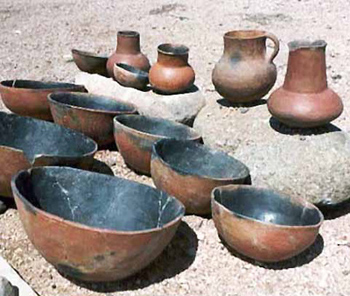
NPS
Roosevelt Red Wares were typically manufactured using a coil-and-scrape method. Clay mixed with either granite, diabase (dolerite), or a mixture of the two, was rolled into thin coils that were then layered atop each other to form the pot (Simon 1996). The sides of the coils were then scraped together using a piece of gourd - an action that served to compress, thin, and smooth the walls of the vessel. The pottery surface was then sanded smooth with a piece of sandstone, slipped, polished, and then decorated before firing in an oxidizing, or open fire, atmosphere (Simon 1996). The variety of paint colors common to Roosevelt Red Wares derived from mineral and organic sources. Red paint, for example, was made from hematite, while white paints derived from kaolin, a pure clay with no iron inclusions. Black paint was commonly manufactured from iron or manganese (mineral- based), charred organic materials, or organic extracts such as that resulting from boiling down beeweed (carbon-based). Although Salado and Salado-style polychrome ceramics are found across a large area in the Southwest, they were produced at a local, household level with local resources. Likewise, these wares are found in a variety of contexts, including household, communal, and burial environments. Vessel form and painted designs vary from type to type and through time, with evidence suggesting that some variation was also the result of specialization in ceramic manufacture by individual communities (Simon 1996). Identification of these specialized communities and the specific chracteristics of locally manufactured wares has provided evidence for complex intraregional social networks in the Classic period Southwest.
Tonto Basin Salado Polychrome Pottery
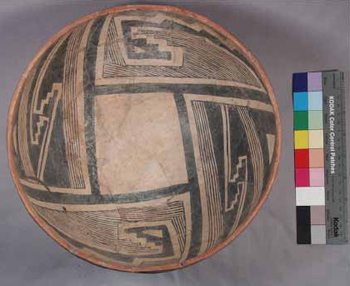
NPS
Tonto Basin polychrome ceramics encompass three distinct styles of red, white, and black painted pottery. Manufacture of the earliest Salado polychrome ware - Pinto Polychrome and Pinto Black-on-Red - began around A.D. 1275, during the Roosevelt Phase. Gila and Tonto polychromes developed later, appearing early in the 1300s, during the Gila Phase (Simon 1996).
Pinto Polychrome
Pinto Polychrome was produced between A.D. 1270 and 1300. Typically the exterior of the vessel had a red slip and an interior white slip with black organic or mineral paint designs. Designs were geometric made using lines, curves, and rectangles. Pinto Polychrome had the most restricted distribution of all three wares that extended only from east-central Arizona to southeastern Arizona. (Simon et al. 1998 and Houk 1992).
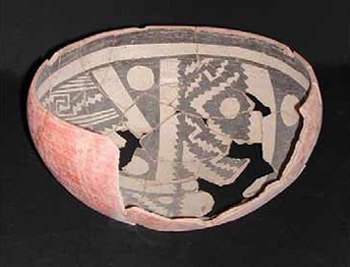
NPS
Gila Polychrome
Gila Polychrome was between A.D. 1300 and the 1400s. Typically these wares had a similar color scheme to the Pinto polychromes, but had complex, asymmetrical designs. The designs were made with scalloped edges and a negative diamond “eye” on triangles, scrolls, keys, mazes, and hatches (Houk 1992). The Gila wares were typically fashioned into bowls, jars, and sometimes effigy vessels. Gila bowls tend to have a lifeline, or a broad band of paint around the rim (Houk 1992; Simon 1996). Gila Polychrome had the widest-range of all pottery types in the southwest. Many of these vessels were made locally, and not necessarily made and then traded by the Salado people.
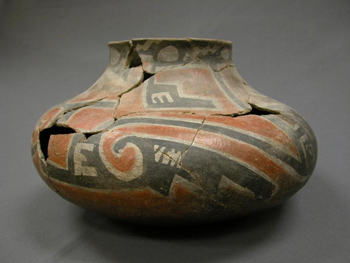
NPS
Tonto Polychrome
Tonto Polychrome appears similar to Gila Polychrome and was produced ontemporaneously. Tonto polychrome “differs only in that red was sometimes applied over the white slip and between the black elements of the design, and the black and white designs sometimes were painted on the outside of the pots” (Houk 1992:8). Vessels were shaped into small bowls, squat jars, and sometimes ollas. This ware was also widely distributed across the Southwest.
Sub-Regional Polychrome Varieties
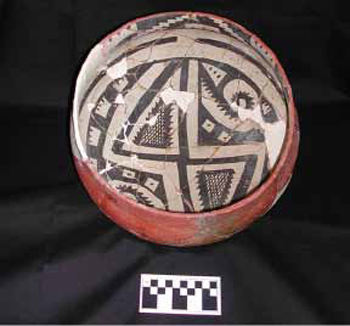
NPS
Many late regional varieties of Salado-style polychromes emerged in areas influenced by the Salado culture of the Tonto Basin. These wares include Cliff Polychrome, Nine Mile Polychrome, Phoenix Polychrome, Dinwiddie Polychrome, Los Muertos Polychrome, and Cliff Red-on-white.
Cliff Polychrome
Cliff Polychrome appears in the archeological record around A.D. 1350, and is a variation of Gila Polychrome. Cliff vessels were typically bowls with dual interior black-on-white design fields separated by banding lines (Neuzil and Lyons 2005). This type is most commonly found in southeastern Arizona and southwest New Mexico.
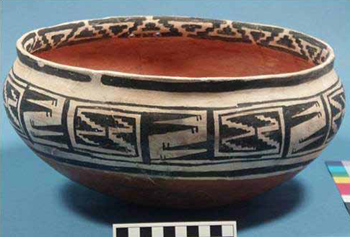
NPS
Nine Mile Polychrome
Nine Mile Polychrome was also produced primarily in bowl form, and like Cliff Polychrome, has a banded design field on the interior surface at the rim. A black design is painted on a white band of white slip. However, the interior of the bowl is slipped red instead of bearing the black-on-white patterns found on the Cliff wares. The outside of Nine Mile Polychrome bowls are almost always painted with black-on-white designs (Neuzil and Lyons 2005). This ware is typically found in southeastern Arizona, and appears around A.D. 1375.
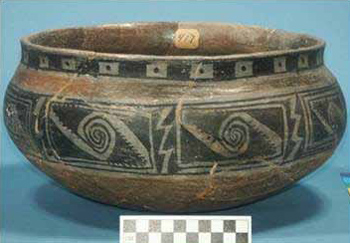
NPS
Phoenix Polychrome
Phoenix Polychrome appears around A.D. 1375, and has been recovered from sites in the Phoenix Basin and as far east as Cliff Valley, New Mexico. The northern extent in which this pottery has been found includes the Middle Verde Valley and Perry Mesa. This type is similar to Nine Mile Polychrome, but does not have a black-on-white interior band. Instead, the entire interior of the bowl is typically slipped red. Exterior designs are similar to those on Gila and Tonto polychromes.
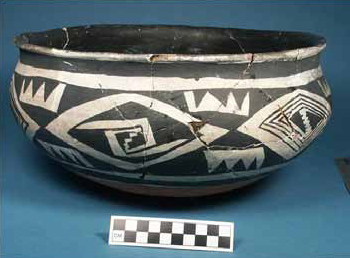
NPS
Dinwiddie Polychrome
Dinwiddie Polychrome is similar to Phoenix Polychrome, but has a smudged interior. Some Dinwiddie Polychrome pottery also resemble Gila and Tonto polychromes. This ware has a limited spatial distribution that includes southeastern Arizona and southwestern New Mexico. Like the Phoenix Polychrome, this type dates between A.D. 1340 and 1450.
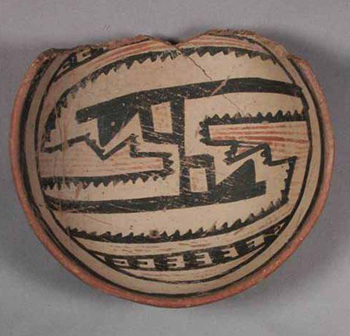
NPS
Los Muertos Polychrome
Los Muertos Polychrome resembles Gila Polychrome in design, but differs in the placecment of red paint adjacent to black-painted elements. The distribution of this type is spatially limited to the Verde Valley, the Agua Fria-Perry Mesa area, the Lower Salt River Valley, the Middle Gila, the Santa Cruz Flats, and the Tonto Basin, and is most common in the southwestern portion of this area. Los Muertos Polychromes also dates between A.D. 1340-1450.
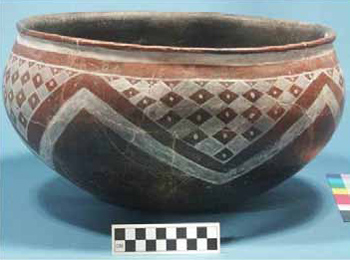
NPS
Cliff White-on-red
Cliff White-on-red is characterized by a well-polished surface, a red exterior with white-painted designs, and a smudged interior. Cliff White-on-red typically appears in bowl form and is limited in range to southwestern New Mexico and southeastern Arizona. Cliff wares date between A.D. 1340 and 1450.
Understanding the Salado Phenomenon
Current interpretations of the Salado and Salado-style Roosevelt Red Wares suggest that the Tonto Basin polychromes - Pinto, Gila, and Tonto - developed out of an amalgamation of ceramic traditions (Simon 1996), and spread from the Tonto Basin in central Arizona to encompass a vast spread of the Southwest, perhaps as an iconographic representation of religious belief and participation (Crown 1994). Identification of local variants - Cliff Polychrome and Red-on-white, Nine Mile, Phoenix, have helped in determining individual community and ethnic participation in this “Salado Phenomenon,” and may also provide an indication for where Salado people migrated once they began leaving the the Tonto Basin ca. A.D. 1350.
Literature Cited
Crown, Patricia
1994 Ceramics and Ideology: Salado Polychrome Pottery. University of New Mexico Press, Albuquerque.
Houk, Rose
1992 Salado: Prehistoric Cultures of the Southwest. Southwest Parks and Monuments Association, Tucson.
Neuzil, Anna A. and Patrick D. Lyons
2005 An Analysis of Whole Vessels from the Mills Collection Curated at Eastern Arizona College, Thatcher, Arizona. Technical Report No. 2005-001. Center for Desert Archaeology, Tucson.
Simon, Arleyn W.
1996 Pottery and Pigments in Arizona: Salado Polychrome. Matrials Research Bulletin 21(12):38-47.
Simon, Arleyn W., James H. Burton, and David R. Abbott
1998 Intraregional Connections in the Development and Distribution of Salado Polychromes in Central Arizona. Journal of Anthropological Research 54:519-547.
Prepared by Catherine Daquila and Duane Hubbard, National Park Service, 2008.
PDF: Salado Polychrome
Last updated: August 14, 2017
